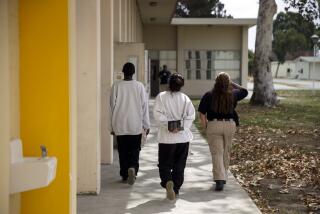Children’s Homes: New Rules Hurt
- Share via
SANTA ANA — The county’s Social Services Agency and several privately run group homes for abused and neglected children find themselves in the awkward position of opposing tough new state regulations designed to help infants and toddlers in protective custody.
Several group homes have already stopped accepting children under 6 in anticipation of the rules, which would require more training for group home workers and double the number of staffers who must tend to these abused children.
The measures stem from a 1993 state law designed to beef up services for drug-affected babies and other troubled kids. The law is just now being converted into a set of regulations.
County officials said the rules are well-intentioned but amount to costly overkill--especially at Orangewood Children’s Home, where 40% of the roughly 280 residents are under age 6.
Critics insist that implementation of the state law would have unintended consequences, such as separating siblings in protective care and limiting the placement of toddlers and infants.
If private group homes shut their doors to children under 6, officials fear that Orangewood, the county’s only emergency shelter, will be able to place fewer and fewer children, exacerbating the already overcrowded conditions there.
“Our concern is that children aren’t going to be served, because the homes can’t afford the kind of staffing and facilities required,” said Mary Ann Xavier, executive director of Florence Crittendon Services.
Like Xavier, Dan McQuaid, executive director of Canyon Acres group homes, said his facilities cannot afford to comply with the requirements. As a result, Canyon Acres stopped accepting children under 5 several months ago.
Olive Crest, one of the area’s largest group home operators, probably will end service to most infants and toddlers if the rules take effect, said President Donald Verleur. “Economically, it would be very difficult,” he said.
The regulations are designed in part to provide greater oversight of infants and toddlers who have been ordered into protective custody by the courts.
Peter Castillo, senior staff counsel for the state Department of Social Services, said the Legislature believed that shelter and home workers needed more training in early childhood education, infant care and dealing with children who suffer from emotional problems.
“Until now, the regulations didn’t make any differentiation based on the age of the child,” Castillo said. “The group homes were designed for older children. With more and more younger children coming in, the feeling was they needed special regulations.”
Besides additional training, the proposed rules would change the child-to-staff ratio at many facilities from 6-to-1 to 3-to-1, and would set a 30-day limit for children under 5 to stay in shelters and some larger group homes.
Though the legislation was passed in 1993, the state didn’t begin working on the rules until last year, after the Family Law Center of San Francisco filed a lawsuit charging that officials were dragging their feet. The judge agreed to place the suit on hold after the state agreed to begin drafting the regulations.
With group homes cutting off service, more young children would end up at Orangewood, which was designed for 236 residents but often houses 280 to 300.
“Philosophically, I support the basis for the law,” said Dr. Michael Riley, director of the county’s Children and Family Services Department. “But there is such a dearth of resources for the kids that we have to bring into custody that unfortunately we don’t have any place to put them.”
It’s unclear exactly how much it would cost Orangewood to comply with the rules, but officials said the Board of Supervisors would either have to allocate additional funds or take money away from other programs.
Riley and others said they are concerned about how the regulations would affect siblings of different age groups. “It’s not uncommon that we have large sibling sets, ages 1, 3, 6 and 14,” he said. “If these regulations go into effect, we will have two sets of standards for one set of siblings,” meaning the children would probably be split up.
Officials also expressed concern about the 30-day limit, noting that “drug babies” and other children with physical or mental illnesses are sometimes better off in shelters with 24-hour supervision than in foster homes.
“Standards and regulations can sound like a good idea but then backfire,” added Board of Supervisor Chairman William G. Steiner. “I think we have a good level of supervision and oversight at Orangewood.”
Various county social service agencies and group home organizations across California are urging the state to modify the regulations before they are implemented early next year.
But Carole Shauffer, director of the Youth Law Center and an architect of the original law, said critics are overestimating the drawbacks and underestimating the benefits.
“This is in the best interests of children,” Shauffer said. “These are very basic standards.”
More to Read
Sign up for Essential California
The most important California stories and recommendations in your inbox every morning.
You may occasionally receive promotional content from the Los Angeles Times.











